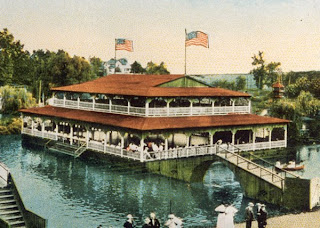 |
| Entrance Archway at Brandywine Springs |
From its earliest days, the residents of Mill Creek Hundred have always been an industrious, hard-working bunch. And for a brief, shining time in the late 1800's and early 1900's, local residents and guests from far afield had a beautiful place to unwind and enjoy a relaxing day out -- Brandywine Springs Amusement Park.
Although the amusement park is usually dated to 1886, the history of the site on the southeast corner of Newport-Gap Pike and Faulkland Road goes back much further. The Yarnall, or Conestoga, Tavern had been in operation since the 1700's, and a large resort hotel was constructed on the site in the late 1820's. This first hotel burned to the ground in 1853, but the site was far from done. Immediately afterwards, a second hotel was created by combining three houses on the site that had been built 20 years earlier by a former hotel manager. This second hotel plugged along with limited success until 1886, when Philadelphian Richard Crook was brought in to manage it.
With the Wilmington and Western Railroad having been built along the edge of the property in 1872, Crook looked for ways to draw patrons to the hotel. He hit upon the idea of adding small amenities to the hotel grounds, like a picnic grove, tennis courts, and a small merry-go-round. These seemed to do the trick. Before long, Crook noticed that these added attractions were drawing more people than the hotel itself. Being a savvy businessman, he decided to take his success and run with it. Over the next 10-15 years, the site, since renamed the "Brandywine Springs Amusement Park", slowly but steadily added new attractions until it boasted such things as a dance hall, a roller coaster, two theaters, a restaurant, a larger carousel, and a boardwalk. There were many other rides and games, and more were to follow. The park really took off, though, with the 1900 completion of Richard Crook's other venture -- the Peoples Trolley.
With the trolley line finally completed after years of construction, acquisitions, and court battles, the people of Wilmington (and beyond, with link-ups to a steamboat line on the Delaware) had easy access to the park. It cost five cents to ride the trolley from Wilmington, and there was no entrance fee to get into the park. Visitors simply paid as they went for rides, games, shows, or meals. In an era before air-conditioning, many city-dwellers came to the park just to have a cool, shaded, "day in the country". Those looking for more adventure could ride the Toboggan Slide or Scenic Railway roller coasters, rent boats on Lake Washington, see a moving picture at one of the first movie theaters in Delaware, or try their luck at one of the many games along the boardwalk. If that wasn't their "thing", there were also two theaters that hosted plays, operas, musical acts, travelling performers, and speakers (like Carry Nation). For hungry patrons, there was a full service restaurant and several smaller foodstands throughout the park.
 |
| Dance Hall on Lake Washington |
The park enjoyed its heyday from about 1900-1915, then began its gradual decline. This decline began when, in 1915, founder Richard Crook retired and sold the park and the trolley line to the Wilmington and Philadelphia Traction Company. The WPTC owned the other major trolley line in Wilmington, as well as their own amusement park, Shellpot Park, located just north of the city. Although Shellpot had always been a smaller competitor to Brandywine Springs, it was "their park" and over the next few years it seems that more money, upkeep, and advertising went to Shellpot than to Brandywine Springs. As rides broke down or buildings burned, they were just left and not repaired or replaced. By the early '20s, the park had almost reverted back to being the picnic park it began life as. And although there was talk of rebuilding the park under new management prior to the 1924 season, the park never reopened. Soon, much of the building material that made up the park was scavenged by local residents, leaving only a few foundations to accompany the joyous memories of the biggest attraction in the history of Mill Creek Hundred.
For anyone interested in learning more about Brandywine Springs (besides waiting for future posts about it here), there are several resources available. On the web, the Friends of Brandywine Springs (FOBS) have an excellent site with more information and pictures of the park. FOBS also has an informative display about the park, as well as some of the artifacts uncovered during their archaeological digs, in the Red Clay Valley Visitor's Center at the Wilmington and Western Railroad at Greenbank. The museum is open from 11:45 - 2:30 on Saturdays and Sundays when the train is in operation, and the archaeological digs are open to the public. Finally, if you can find it, the definitive book about the park, Brandywine Springs Amusement Park: Echoes of the Past 1886 - 1923, was written in 1993 by Mark Lawlor. It's out of print, but you can still find it sometimes on places like eBay.
No comments:
Post a Comment